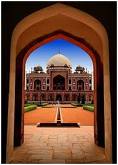The Qutub Minar is a tower located in Delhi, India. It is the world's tallest brick minaret with a height of 72.5 meters (237.8 ft). It has a diameter of 14.32m at the base and about 2.75m on the top.
Qutub Minar, an architectural marvel of the 13th century, is located in Delhi, the capital of India. One of the most famous landmarks of Delhi, viewing it is trully an experience to relish. Qutub Minar complex monuments are listed in the UNESCO world heritage sites of India. Here is concise information about Qutub Minar in Delhi. Qutb-u'd-Din Aibak, the first sultan of Delhi, laid the foundation stones of Kutub Minar in AD 1199. Some historian opine that that the objective behind its construction was to give a platform to Mu'azzin to give calls for prayer. He was the one who raised the first storey. Then he died. The credit of completing the construction goes his successor and son-in-law, Shamsu'd-Din Iitutmish, who also added three more stories to it.
MAIN ATTRACTIONS IN QUTUB COMPLEX
Alai Darwaza
The Alai Darwaza is the main gateway from southern side of the Quwwat-ul-Islam Mosque. It was built by the second Khilji Sultan of Delhi, Ala-ud-din Khilji in 1311 AD, who also added a court to the pillared to the eastern side.
Quwwat-ul-Islam Mosque
Quwwat-ul-Islam mosque (Might of Islam) (also known as the Qutb Mosque or the Great Mosque of Delhi) was built by Qutb-ud-din Aybak, founder of the Mamluk or Slave dynasty.
Iron Pillar
Iron Pillar in the Qutab Minar Complex harks back to the 5th century. It has faced the wear and tear of time successfully
Iron Pillar in the Qutab Minar Complex harks back to the 5th century. It has faced the wear and tear of time successfully
Tombs
Iltutmish
The tomb of Slave Dynasty ruler, Iltutmish, the second Sultan of Delhi (r. 1211-1236 AD), built 1235 AD is also part of the Qutb complex at Mehrauli.
Imam Zamin
Tomb of Imam Muhammad Ali, or Imam Zamin, stand on a raised courtyard, next to the Alai Darwaza. According to an inscription of the eastern entrance to the tomb, Imam Zamin was a saint from Turkestan, who settled in India in around 1500, during the Sikander Lodhi
Alauddin Khilji's tomb and madarsa
At the back of the complex, southwest of the mosque, stands an L-shaped construction, consisting of Alauddin Khilji's tomb dating ca 1316 AD, and a madarsa, an Islamic seminary built by him. Khilji was the second Sultan of Delhi from Khilji dynasty, who ruled from 1296 to 1316 AD.
Alai Minar
Alauddin Khilji started building the Alai Minar, after he had doubled the size of Quwwat ul-Islam mosque. He conceived this tower to be two times higher than Qutb Minar in proportion with the enlarged mosque. The construction was however abandoned, just after the completion of the 24.5 meter high first storey core; soon after death of Ala-ud-din in 1316 AD.
BEST TIME TO VISIT: October to March
HOW TO REACH QUTUB MINAR
By Air : Delhi has two airports – Indra Gandhi International Airport and Palam Domestic Airport. Both these airports are connected with regular flights from important cities of the country and the world as well. Frequent shuttles run between these airports.
By Train : Delhi has three major railheads namely – Delhi, New Delhi and Hazrat Nizamuddin railway station. These stations are served by many express and super fast trains from various parts of the country.
By Bus : Good motorable roads including National Highways and State Highway link Delhi with nearby states and rest of the country.
Local Transport : Buses, Taxis, Cars, Auto-rickshaws are available as local modes of transport, you can reach Qutab Minar by opting any mode. Metro railway is new attraction in Delhi but presently it is not linked to Qutab Minar.
ACCOMODATION
Plenty of accommodation options are available in Delhi that suit your budget. Choose from wide array of hotels ranging from five star to tourist lodges and enjoy a pleasant stay during your Delhi trip.
GET DIRECTIONS
View Larger Map

















































